|
EZ
Movement Framework  By: Karen
Weiler, University of North Texas
& Jennifer
Bridges
By: Karen
Weiler, University of North Texas
& Jennifer
Bridges
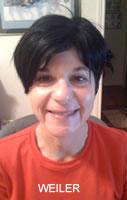 Why
is it important for children to become
competent with the “basics”
in physical education? Children have
needs to develop their thinking, feeling,
and moving abilities. Without each of
these, the child will be limited, and
likely be limited as an adult. Most
of us know that every academic content
area has basic fundamentals upon which
most every other concept is built. What
most of us fail to recognize is that
this is also true for physical education
content. Why
is it important for children to become
competent with the “basics”
in physical education? Children have
needs to develop their thinking, feeling,
and moving abilities. Without each of
these, the child will be limited, and
likely be limited as an adult. Most
of us know that every academic content
area has basic fundamentals upon which
most every other concept is built. What
most of us fail to recognize is that
this is also true for physical education
content.
Our focus is to present an EZ framework
for teaching physical education with
which many of you may be already familiar,
the movement education framework (MEF).
We suggest that it serves as the “core”
of physical activity, particularly at
the elementary level. Finally we will
provide this basic foundational content
information in physical education in
an easy to understand, meaningful, and
practical manner for all elementary
physical education teachers, and maybe
some classroom teachers as well!
The movement education framework is
not a new idea. It was popular in the
1960s, 1970s, and even into the 1980s,
but seemed to lose favor over the next
two decades as a teaching method. However,
with the development of the first set
of national standards for physical education;
“Moving into the Future”
(1995) by the National Association for
Sport and Physical Education (NASPE),
movement concepts became recognized
as a critical component for all physically
educated persons to know and do. Movement
education fits most directly into the
standards (NASPE, 2004) as explicitly
stated in the first two of the six national
physical education content standards.
Language in Physical Education
The NASPE national standards have made
it clear children not only need to move,
but they should also know how to move,
and should have a vocabulary for communicating
appropriately about movement. Thus we
have developed a version of the movement
framework for teaching and understanding
the movement concepts that children
can be introduced to (the ladder), and
a more complete version that older children
and adults should know (the “Flip-n-fold”).
To help teachers, in both the gymnasium
and classroom present this material,
we have developed some specific teaching
tools (pocket chart cards and word wall).
Finally, we provide a few examples of
implementing these ideas.
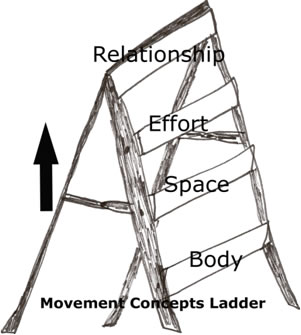 MEF:
The EZ Version! MEF:
The EZ Version!
We begin with identifying the four basic
movement concepts, and their associated
movement elements that form the same
type of foundation in physical education
as the “A, B, C’s”
do for literacy and the “1, 2,
3’s” do for mathematics.
There are four movement concepts (body,
space, effort, and relationships) that
are the essence of the movement education
framework. Presentation of the MEF can
be represented in an overall manner
by a ladder. This tool is designed as
a simple visual aid to help teachers
present the Movement Education Framework
in a way in which young children can
relate. The movement concept ladder
is an easy to understand idea using
a symbol easily recognized by children.
The ladder can help a teacher to prioritize
and organize answers to the basic movement
concept questions: What do we move,
Where do we move, How do we move, and
With whom or what do we move?
Basically, the movement concepts begin
with the body, which is the tool of
movement. In order to move, one must
have a means of moving. The Body,
its parts, and its most basic or fundamental
movements serve as the foundation of
this framework: it is then, Step One
of the ladder. So, now that there is
something to move with, the body needs
to go somewhere, or be able to use the
Space for movement; therefore, the movement
concept of Space is
Step Two of the ladder. How one moves
in this space is the movement concept
of Effort and thus
it follows Space as Step Three of the
ladder. The most complex of the movement
concepts is Relationships,
so it is the top rung of the ladder.
Progression of the concepts is not
purely linear, and one does not have
to complete each step prior to moving
on to the next. There is plenty of overlap
as concepts are reviewed, and challenges
are created at higher levels of complexity.
However, the basic idea of the ladder
is simple and easy to remember, making
it a good introduction to the organization
of movement concepts.
The Complete Framework
We have provided a presentation
of the entire movement framework. The
Movement Education Framework: Concepts,
Categories, and Elements book
fold reference was created to facilitate
an easy visual organization of the material.
The size of this book fold reference
makes it easily stored in a pocket,
or on a clip board when teaching, and
makes a handy tool for the teacher and
even for the students! Each page of
the book fold document (which we gave
the nickname: “Flip-n-fold”
because of the two folding procedures
to make an 8.5” x 11” piece
of paper) reads like a book.
Although the concepts and categories
are important, it is really the movement
elements that describe the actual movement
to be performed. Teaching the movement
elements is the priority over any of
the other content/terms (i.e. movement
concepts or movement categories). The
elements can be combined into activities
and tasks. Definitions for all movement
elements can be found in Movement education:
Foundation for active lifestyles, published
by Human Kinetics (April 2009).
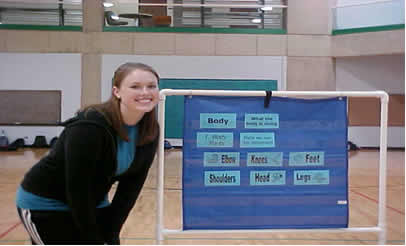 New
Tools to Help Teach the MEF! New
Tools to Help Teach the MEF!
The first of these tools includes the
use of pocket charts, and pocket chart
cards that are designed specifically
for use with physical education content.
Pocket charts and pocket chart cards
are an old standby for elementary level
classroom teachers. The elementary classroom
teacher who is very often also responsible
for fulfilling mandated Physical Education
minutes can use these cards and teach
with materials and methods where they
as teachers already excel!
Using pocket charts in the gymnasium
is a logical and natural fit. In fact,
the gymnasium offers an exciting environment
to use the versatile pocket chart and
pocket chart card tools. An example
of a pocket chart with movement education
cards placed in the pockets for a lesson
can be seen on the figure to the left
hand side. A sample of an entire deck
of movement concept cards is shown below.
One of the first lessons should be
to introduce the movement framework.
It is helpful to organize the material
into a few big chunks that the children
can remember. To begin, place the pocket
card “Movement Concepts”
at the top center of the first pocket
in the chart. Similarly, the teacher
can point to the words “Movement
Concepts” on a word wall.
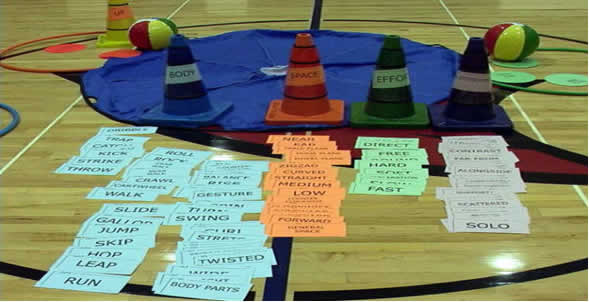 Explain
to the children that they are going
to be learning about four big ways in
which the body moves. The teacher should
then place each of the four MEF concepts
on a separate line of the pocket chart
(i.e. Body, Space, Effort, and Relationship)
or point to them on the word wall. Children
can be asked to read the words. Explain
to the children that they are going
to be learning about four big ways in
which the body moves. The teacher should
then place each of the four MEF concepts
on a separate line of the pocket chart
(i.e. Body, Space, Effort, and Relationship)
or point to them on the word wall. Children
can be asked to read the words.
After the movement framework and four
concepts have been introduced, children
can be challenged to remember them.
The teacher can place the four movement
concept cards among ten or so other
cards from the deck randomly within
a circle on the floor so that all cards
can be seen.
It might be helpful to provide an analogy
for the children; movement is like soup,
we can put all kinds of things in our
soup. Let’s see if you can find
the four basic movement soup ingredients
from the pot of soup on the floor. This
teacher in Madison Wisconsin created
simple pictures taped to the wall to
make her movement soup analogy.
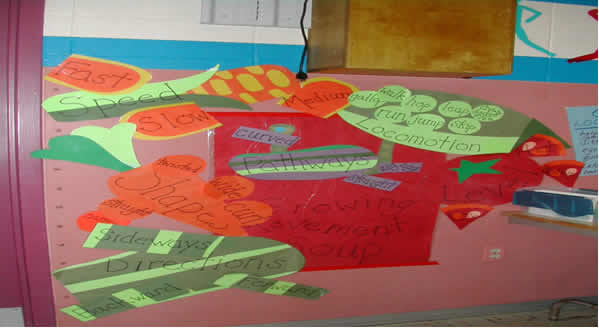 Word
walls are great tools and can be used
to bridge the gap between the gymnasium
and the classroom. The Word Wall can
also be used in the gym as well as in
the classroom. Word
walls are great tools and can be used
to bridge the gap between the gymnasium
and the classroom. The Word Wall can
also be used in the gym as well as in
the classroom.
An example of a word wall designed
specifically for gymnasium use, as well
as classroom use, is shown in the figure
below. Four examples of Word Wall activities
(one from each concept area) are listed
below. Many additional examples may
be found in Movement education: Foundation
for active lifestyles.
Body activity: Body shapes
1.We can make lots
of shapes with our bodies. Some are
tall and stretched, and some are wide.
Who can find four types of body shapes
we can make (have children point to
narrow, wide, round, twisted)? In your
own personal space, show me a narrow
shape, a wide shape, a round shape,
and a twisted shape. When the music
begins, you will travel around all the
general space and when the music stops
freeze and make your body into one of
the four shapes we practiced. Make your
shape really clear and hold it for a
count of three.
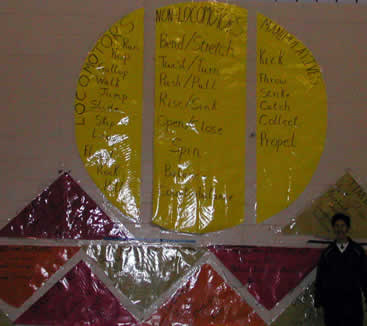 Space
activity: Personal and General space Space
activity: Personal and General space
2. We have lots of
room in our gym. This is called our
general space. That is all the space
we have available for us to move. Can
someone find the words general space
on the Word Wall? When you hear the
start signal, show me how you can travel
in all our general space. Remember,
we learned about personal space, so
as you travel, I do not want to see
collisions. (Have children travel using
various locomotor skills).
Effort activity: Time
3. I am wondering if
anyone can find the words fast,
slow, and acceleration
on our Word Wall. We know what fast
and slow means, but what does acceleration
mean? (Make certain children understand
acceleration refers to a change in speed).
As you move all around our general space,
can you show me fast movements, slow
movements, and then changes in speed?
Let’s start out with slow movements.
(Younger children may wish to think
of animals or cars that move slowly
or more quickly). Now, let’s move
more quickly. Can you show me changes
in speed as you travel? Think of three
different movements to do in a row,
one slow, one fast, and one that shows
changes in speed.
Relationships activity: Partners
4. What does it mean
to work with a partner? (Children should
reply with cooperation words). Today,
we are going to work on finding partners
and working with our partner. When I
say go, find a partner who has the same
color bean bag as you do. If you do
not have a partner by the time I count
to five, come see me. See if you and
your partner can toss your bean bags
back and forth. Can you toss them low,
medium, and high? We are working on
tossing and catching so you are showing
me how you can work with your partner.
I want you and your partner to think
of three different types of tosses.
You might choose to do one low, and
two medium tosses, or you might choose
to do one high and two low. You decide.
I am looking for good partner work and
tossing and catching. Go. (At the end
of the task, ask students to tell you
how they worked with their partner and
to give their partner a thank you for
being their partner).
In summary, children need to know as
well as be able to do the basic movements
outlined in the movement education framework.
The ladder provides a simple tool to
help children understand the four most
basic ideas. However, the teacher needs
a more complete framework, one that
is practical, yet sufficient. The “Flip-n-fold”
is our answer to this need, and we hope
it provides a tool for daily use in
the gym. We have developed a variety
of tools to help teachers deliver this
content in either the regular classroom
or in the gymnasium; ideally both settings
would use them. Finally, the MEF approach
can provide all children with a view
of physical education that fosters success,
activity, and contribution by all! We
hope you agree!!
(pelinks4u
home) |



